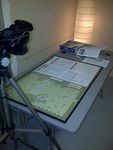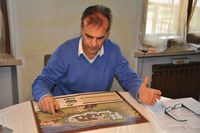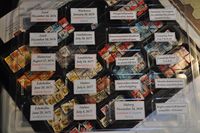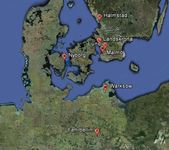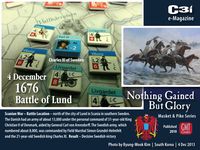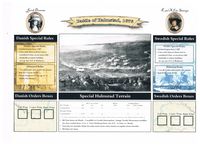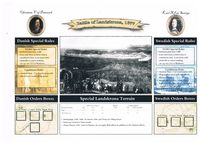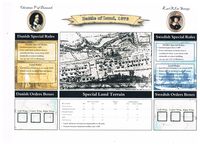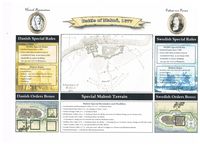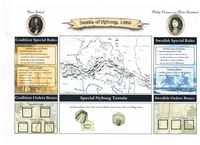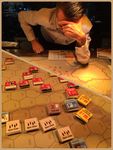


|
|
|
|
1-2
300'
No necessary in-game text
|
Nothing Gained But Glory

Nothing Gained But Glory will be the fifth volume from the award winning Musket & Pike Battles Series. It features several pivotal battles in Baltic region of the late 17th century - a period where rulers struggled to centralize power in their realms and to introduce permanent standing armies instead of expensive mercenary forces. It shows the highly trained and well led army of Sweden struggling to defend its massive gains from the Thirty Years War and the Northern Wars of 1655-1661 against the forces of Denmark and Brandenburg, reinforced by contingents from Austria, the United Provinces, Münster, Hesse-Kassel and Poland. The personalities in the game include the great Swedish warrior king Carl XI, Brandenburg´s Frederick William (the Great Elector), and King Christian V of Denmark-Norway. Never before have so many monarchs been in one M&P box! Nearly all the scenarios in this module are smaller than the typical Musket & Pike scenarios, and thus take less time and space to play. For the same reasons it is a great introductory game to the series. The Historical Background The Scanian War was prompted by the Franco-Dutch War of 1672-1678. Sweden had allied with France against several European countries, and was eventually forced to fulfill her treaty obligations to France by invading Brandenburg. This invasion was an attempt to force Brandenburg to withdraw from the fighting against France, but the invasion was conducted without the usual energy and force of previous Swedish offensives. When the Brandenburg Army returned home much faster than anticipated the Swedes started to withdraw, but were caught by the Brandenburgers and defeated at the battle of Fehrbellin on June 28th 1675. The previously "unbeatable" Swedish Army had lost a battle, and this key event soon persuaded others to join the war. Most notable of these was Denmark, which saw its chance to regain the Scanian lands lost in the Northern Wars. (Scania is the southern tip of Sweden, just across the Oeresund, the Sound, from Denmark.) After mopping up the Swedish possessions of Wismar and Bremen, the Danish Army landed in Scania on June 29, 1676. Danish King Christian V led 15,000 troops against a defending Swedish Army of 5,000 men that were spread out over the province. Initially the operation was a great success. Large parts of the local peasantry sided with Denmark and the outnumbered Swedish troops were in bad shape. Town after town fell into the hands of the Danes and the Swedes had to retreat north to Sweden proper. After a month only the fortified town of Malmö remained under Swedish control. At sea the situation wasn´t any better for the Swedes, as their navy lost several battles against the combined Danish- Dutch Navy, and left the command of the sea in the hands of the allies. Two factors helped to save Sweden from ruin: the splendid courage of their young king who resolutely and successfully kept the Danish invaders at bay, and the diplomatic activity of Louis XIV, the French king. The first ray of light for the Swedish cause came with the battle of Halmstad in August 1675 when the king succeeded in outmaneuvering and destroying a small Danish force sent north to take Halmstad and link up with the forces operating out from Norway. As the Swedish Army slowly grew larger it became possible to meet the Danish main army head on, and the Swedes were victorious at the battles of Lund in December 1676 and Landskrona in June 1677. These battles caused the fighting to stalemate on the Scanian front, as the Danish could supply and reinforce their coastal fortresses by sea, but didn´t dare venture inland to meet the Swedish Army in a field battle again. The focus of the war therefore shifted to the German front once again, where the Brandenburg Army was slowly conquering the Swedish fortresses and fortified cities one by one. The Danish Army sent an expeditionary force to the island of Rügen and captured it, but lost it again in January 1678 after a winter of horrid attrition, when the Swedes returned to the island once more and defeated them in the battle of Warksow. Later in 1678 the Allies would take Rügen once more, and eventually all the Swedish possessions in Germany were lost. Events in Western Europe would once again have far reaching effects on the Baltic as the end of the Franco-Dutch war in 1678 gave France the power to force an end to the Scanian War and dictate the peace treaties of Fontainebleau. These treaties restored almost all the Swedish possessions lost during the war, and so the end result was truly “Nothing Gained but Glory.” The 7 battles included in Nothing Gained but Glory are: Nyborg, November 14, 1659 - (While not part of the Scanian War, this bonus battle from the Northern War of 1655-1660 features many of the same participants.) The Swedes had occupied the Danish island of Fünen, but following the landings of two Allied forces and their subsequent combination the Swedes had to fight to win time for an evacuation from the island. With no more room to retreat and the port town of Nyborg´s fortifications in a sorry state, the 7,000 strong Swedish Army positioned itself in good defensive terrain between a lake and a forest. While command difficulties in the 11,000 strong Allied Army almost cost them the battle, the Allies eventually prevailed, forcing the Swedish Army to flee to Nyborg, where it surrendered the next day. Fehrbellin, June 28, 1675 - Returning from fighting against France to face the Swedish invasion, the highly mobile Brandenburg Army of 5,600 cavalry and 13 guns faced a retreating Swedish Army of 7,000 infantry, 4,000 cavalry and 7 guns outside the town of Fehrbellin. A poor deployment of the Swedish Army combined with aggressive handling of the Brandenburg cavalry forced the Swedes from the field. Although the losses in the battle were about equal, the Swedish Army was severely reduced by the subsequent pursuit, raiding peasant guerilla, desertion, and starvation. While only of minor importance militarily, the victory had an enormous psychological impact: the Swedes, long considered "unbeatable", had been bested. With the myth of Swedish invincibility broken, Denmark decided the time was right to settle its scores with Sweden and entered the war. Frederick William henceforth was known as the "Great Elector" and the army that he and Derfflinger had led to victory became the core of the future famous Prussian Army. Halmstad, August 17, 1676 - After the initial great successes for the Danish forces following the landings in Scania in late June 1676, a small Danish force of 3,500 men under Jacob Duncan was detached from the main army and ordered to advance north to take the town of Halmstad and if possible link up with the Norwegian forces under General Gyldenløve. Sensing the possibility of destroying the unsupported Danish detachment, the Swedish king reacted and by heavy force marching succeeded in cutting off Duncan from his line of communications, forcing him to fight his way back. Duncan moved against the Swedes, but then went on the defensive. The Swedes took the initiative, collapsed both of the Danish flanks, and then overwhelmed the center, forcing the army to surrender. This battle ended the Danish plans of linking up with the Norwegians, and provided a much-needed boost to Swedish morale. Lund, December 4, 1676 - This was the bloodiest battle in the history of Scandinavia, with almost 9,000 killed (out of 12,000 Danes and 8,000 Swedes) after an intense day-long battle fought in the chilling cold of the Scandinavian winter. After a cross-river standoff that lasted for a month, the Swedes attacked when the river froze. The Swedes initially had the advantage, and their right wing (along with the king) routed the Danish left and pursued it off the field. The rest of the Swedish Army was then outnumbered, and just as they were about to succumb, the king and part of his wing showed up in the Danish rear, saving the battle for the Swedes. Malmö, June 25-26, 1677 - Malmö, the regional capital of Scania, was the only major town that didn´t fall during the 1676 Danish offensive, and had been a thorn in the Danish side ever since. In June 1677 the Danes decided to take the town by besieging it. When news arrived that the Swedish Navy had set sail to break the blockade of the town and that the Swedish Army was moving to relieve the town, the Danes decided to force the issue and storm the town, even though the siege hadn´t progressed very far. On the Swedish side, the town commander Fabian Fersen prepared his 2,300 strong garrison well, and they fought with desperate courage as they knew it was victory or death. While the Danes were able to scale the wall and break into the city, a determined Swedish counterattack destroyed them before they could open the gates for more Danish troops. (This is a medium sized battle on a half map with various special rules to reflect the many special circumstances of storming a fortified town at night.) Landskrona, July 14, 1677 - After the defeat of the Danish Army at Malmö, the Swedish king decided the time was right to attack them before they could be reinforced by their German and Austrian allies. He thus moved his 10,000 regulars and 4,000 peasant militia towards the Danish Army located at Landskrona. However, the Danes had received their reinforcements that replenished their numbers to 14,000, and the Danish king felt confident about fighting a field battle. This was a hard-fought battle which saw both armies experimenting with combined arms wings and the personal involvement of the monarchs of both armies. Warksow, January 18, 1678 - As the war had reached a stalemate on the Scanian front the Danish forces invaded the island of Rügen in the fall of 1677. They quickly conquered most of the island except for a small Swedish fortified bridgehead. As supplies ran low and attrition ravaged the army, large parts of the Danish expedition were withdrawn from the island, leaving just under 5,000 men. This allowed the Swedes to transfer 3,500 men from their field army in Germany to the remaining bridgehead in early January 1678 and try to take back the island. The armies met at Warksow, where a Swedish cannonade killed the commander of the Danish Army, paralyzing it. Most of the Danish expeditionary force was captured during the battle or in the aftermath as the Swedes quickly cleared Rügen. Components: 1 series rulebook 1 playbook 3 countersheets 2 2.5 map sheets, 2 of which are backprinted 1 10-sided die 3 Player Aid Cards
| Mechanics: | Dice Rolling Hex-and-Counter Simulation |
| Categories: | War |
| Alternative names: | |
| In 3 collections This was seen 4236 times | |
Nothing Gained But Glory will be the fifth volume from the award winning Musket & Pike Battles Series. It features several pivotal battles in Baltic region of the late 17th century - a period where rulers struggled to centralize power in their realms and to introduce permanent standing armies instead of expensive mercenary forces. It shows the highly trained and well led army of Sweden struggling to defend its massive gains from the Thirty Years War and the Northern Wars of 1655-1661 against the forces of Denmark and Brandenburg, reinforced by contingents from Austria, the United Provinces, Münster, Hesse-Kassel and Poland. The personalities in the game include the great Swedish warrior king Carl XI, Brandenburg´s Frederick William (the Great Elector), and King Christian V of Denmark-Norway. Never before have so many monarchs been in one M&P box! Nearly all the scenarios in this module are smaller than the typical Musket & Pike scenarios, and thus take less time and space to play. For the same reasons it is a great introductory game to the series. The Historical Background The Scanian War was prompted by the Franco-Dutch War of 1672-1678. Sweden had allied with France against several European countries, and was eventually forced to fulfill her treaty obligations to France by invading Brandenburg. This invasion was an attempt to force Brandenburg to withdraw from the fighting against France, but the invasion was conducted without the usual energy and force of previous Swedish offensives. When the Brandenburg Army returned home much faster than anticipated the Swedes started to withdraw, but were caught by the Brandenburgers and defeated at the battle of Fehrbellin on June 28th 1675. The previously "unbeatable" Swedish Army had lost a battle, and this key event soon persuaded others to join the war. Most notable of these was Denmark, which saw its chance to regain the Scanian lands lost in the Northern Wars. (Scania is the southern tip of Sweden, just across the Oeresund, the Sound, from Denmark.) After mopping up the Swedish possessions of Wismar and Bremen, the Danish Army landed in Scania on June 29, 1676. Danish King Christian V led 15,000 troops against a defending Swedish Army of 5,000 men that were spread out over the province. Initially the operation was a great success. Large parts of the local peasantry sided with Denmark and the outnumbered Swedish troops were in bad shape. Town after town fell into the hands of the Danes and the Swedes had to retreat north to Sweden proper. After a month only the fortified town of Malmö remained under Swedish control. At sea the situation wasn´t any better for the Swedes, as their navy lost several battles against the combined Danish- Dutch Navy, and left the command of the sea in the hands of the allies. Two factors helped to save Sweden from ruin: the splendid courage of their young king who resolutely and successfully kept the Danish invaders at bay, and the diplomatic activity of Louis XIV, the French king. The first ray of light for the Swedish cause came with the battle of Halmstad in August 1675 when the king succeeded in outmaneuvering and destroying a small Danish force sent north to take Halmstad and link up with the forces operating out from Norway. As the Swedish Army slowly grew larger it became possible to meet the Danish main army head on, and the Swedes were victorious at the battles of Lund in December 1676 and Landskrona in June 1677. These battles caused the fighting to stalemate on the Scanian front, as the Danish could supply and reinforce their coastal fortresses by sea, but didn´t dare venture inland to meet the Swedish Army in a field battle again. The focus of the war therefore shifted to the German front once again, where the Brandenburg Army was slowly conquering the Swedish fortresses and fortified cities one by one. The Danish Army sent an expeditionary force to the island of Rügen and captured it, but lost it again in January 1678 after a winter of horrid attrition, when the Swedes returned to the island once more and defeated them in the battle of Warksow. Later in 1678 the Allies would take Rügen once more, and eventually all the Swedish possessions in Germany were lost. Events in Western Europe would once again have far reaching effects on the Baltic as the end of the Franco-Dutch war in 1678 gave France the power to force an end to the Scanian War and dictate the peace treaties of Fontainebleau. These treaties restored almost all the Swedish possessions lost during the war, and so the end result was truly “Nothing Gained but Glory.” The 7 battles included in Nothing Gained but Glory are: Nyborg, November 14, 1659 - (While not part of the Scanian War, this bonus battle from the Northern War of 1655-1660 features many of the same participants.) The Swedes had occupied the Danish island of Fünen, but following the landings of two Allied forces and their subsequent combination the Swedes had to fight to win time for an evacuation from the island. With no more room to retreat and the port town of Nyborg´s fortifications in a sorry state, the 7,000 strong Swedish Army positioned itself in good defensive terrain between a lake and a forest. While command difficulties in the 11,000 strong Allied Army almost cost them the battle, the Allies eventually prevailed, forcing the Swedish Army to flee to Nyborg, where it surrendered the next day. Fehrbellin, June 28, 1675 - Returning from fighting against France to face the Swedish invasion, the highly mobile Brandenburg Army of 5,600 cavalry and 13 guns faced a retreating Swedish Army of 7,000 infantry, 4,000 cavalry and 7 guns outside the town of Fehrbellin. A poor deployment of the Swedish Army combined with aggressive handling of the Brandenburg cavalry forced the Swedes from the field. Although the losses in the battle were about equal, the Swedish Army was severely reduced by the subsequent pursuit, raiding peasant guerilla, desertion, and starvation. While only of minor importance militarily, the victory had an enormous psychological impact: the Swedes, long considered "unbeatable", had been bested. With the myth of Swedish invincibility broken, Denmark decided the time was right to settle its scores with Sweden and entered the war. Frederick William henceforth was known as the "Great Elector" and the army that he and Derfflinger had led to victory became the core of the future famous Prussian Army. Halmstad, August 17, 1676 - After the initial great successes for the Danish forces following the landings in Scania in late June 1676, a small Danish force of 3,500 men under Jacob Duncan was detached from the main army and ordered to advance north to take the town of Halmstad and if possible link up with the Norwegian forces under General Gyldenløve. Sensing the possibility of destroying the unsupported Danish detachment, the Swedish king reacted and by heavy force marching succeeded in cutting off Duncan from his line of communications, forcing him to fight his way back. Duncan moved against the Swedes, but then went on the defensive. The Swedes took the initiative, collapsed both of the Danish flanks, and then overwhelmed the center, forcing the army to surrender. This battle ended the Danish plans of linking up with the Norwegians, and provided a much-needed boost to Swedish morale. Lund, December 4, 1676 - This was the bloodiest battle in the history of Scandinavia, with almost 9,000 killed (out of 12,000 Danes and 8,000 Swedes) after an intense day-long battle fought in the chilling cold of the Scandinavian winter. After a cross-river standoff that lasted for a month, the Swedes attacked when the river froze. The Swedes initially had the advantage, and their right wing (along with the king) routed the Danish left and pursued it off the field. The rest of the Swedish Army was then outnumbered, and just as they were about to succumb, the king and part of his wing showed up in the Danish rear, saving the battle for the Swedes. Malmö, June 25-26, 1677 - Malmö, the regional capital of Scania, was the only major town that didn´t fall during the 1676 Danish offensive, and had been a thorn in the Danish side ever since. In June 1677 the Danes decided to take the town by besieging it. When news arrived that the Swedish Navy had set sail to break the blockade of the town and that the Swedish Army was moving to relieve the town, the Danes decided to force the issue and storm the town, even though the siege hadn´t progressed very far. On the Swedish side, the town commander Fabian Fersen prepared his 2,300 strong garrison well, and they fought with desperate courage as they knew it was victory or death. While the Danes were able to scale the wall and break into the city, a determined Swedish counterattack destroyed them before they could open the gates for more Danish troops. (This is a medium sized battle on a half map with various special rules to reflect the many special circumstances of storming a fortified town at night.) Landskrona, July 14, 1677 - After the defeat of the Danish Army at Malmö, the Swedish king decided the time was right to attack them before they could be reinforced by their German and Austrian allies. He thus moved his 10,000 regulars and 4,000 peasant militia towards the Danish Army located at Landskrona. However, the Danes had received their reinforcements that replenished their numbers to 14,000, and the Danish king felt confident about fighting a field battle. This was a hard-fought battle which saw both armies experimenting with combined arms wings and the personal involvement of the monarchs of both armies. Warksow, January 18, 1678 - As the war had reached a stalemate on the Scanian front the Danish forces invaded the island of Rügen in the fall of 1677. They quickly conquered most of the island except for a small Swedish fortified bridgehead. As supplies ran low and attrition ravaged the army, large parts of the Danish expedition were withdrawn from the island, leaving just under 5,000 men. This allowed the Swedes to transfer 3,500 men from their field army in Germany to the remaining bridgehead in early January 1678 and try to take back the island. The armies met at Warksow, where a Swedish cannonade killed the commander of the Danish Army, paralyzing it. Most of the Danish expeditionary force was captured during the battle or in the aftermath as the Swedes quickly cleared Rügen. Components: 1 series rulebook 1 playbook 3 countersheets 2 2.5 map sheets, 2 of which are backprinted 1 10-sided die 3 Player Aid Cards
| Mechanics: | Dice Rolling Hex-and-Counter Simulation |
| Categories: | War |
| Alternative names: | |
| In 3 collections This was seen 4236 times | |









